Articles
- Page Path
- HOME > Korean J Community Nutr > Volume 22(3); 2017 > Article
-
Research Article
- Study on Sugar Consumption of Adult Workers According to Smoking Status
-
Jung-Yeon Yun, Boram Kim, Hee Sun Jeong, Nami Joo

-
Korean Journal of Community Nutrition 2017;22(3):228-237.
DOI: https://doi.org/10.5720/kjcn.2017.22.3.228
Published online: June 30, 2017
1Nutrition Education Graduate School, Sookmyung Women's University, Seoul, Korea.
2Department of Food & Nutrition, Sookmyung Women's University, Seoul, Korea.
3Major in Traditional Dietary Life Food, Graduate School of Professional Studies Traditional Culture & Arts, Sookmyung Women's University, Seoul, Korea.
- Corresponding author: Nami Joo. Department of Food & Nutrition, Sookmyung Women's University, Hyochangwon-gil 52, Yongsan-gu, Seoul 140-742, Korea. Tel: (02) 710-9471, Fax: (02) 710-9479, fanta-fun@sookmyung.ac.kr
Copyright © 2017 The Korean Society of Community Nutrition
This is an Open-Access article distributed under the terms of the Creative Commons Attribution Non-Commercial License (http://creativecommons.org/licenses/by-nc/3.0/) which permits unrestricted non-commercial use, distribution, and reproduction in any medium, provided the original work is properly cited.
- 440 Views
- 1 Download
- 3 Crossref
Abstract
-
Objectives
- The purpose of this study was to investigate the smoking status among adult workers, and current status of sugar intake.
-
Methods
- The survey included 500 men working in Gyeonggi-do from October to November in 2016. Questionnaire items covered their age, working status, smoking status, eating habits, eating behaviors, snack consumption status, habits and behaviors related to sugar intake. All data were analyzed by SPSS program (Ver. 23) and descriptive statistics was performed; a t-test, χ2 test, One-way ANOVA and Scheffe test were used for post-hoc test.
-
Results
- The study results showed that eating habits and behaviors of non-smokers were better than those of smokers. The frequency of daily snack consumption was the highest in smokers compared to and non-smokers. The smokers' favorite taste after smoking was ‘Sweet’. The average score of sugar-related nutrition knowledge was higher in non-smokers compared to smokers. Non-smokers had better recognition of ‘sugar reduction’, and smokers were more likely to eat sweet foods, respectively. On the other hand, non-smokers could observe that they were trying to control themselves for health reasons. According to the results of the study, non-smokers showed better eating habits and dietary habits and consumed less sugar. Also, it was found that non-smokers tried to drink more water than beverages and refrain from eating sweets to reduce their sugar intake. Further, the most of the bread, coffee and beverages were also consumed at a lower frequency by non-smokers compared to smokers.
-
Conclusions
- This study results showed that smoking and sugar consumption were closely related. Therefore, adult workers should actively promote and learn so that they can maintain healthy and suitable dietary habits through reduction of sugar consumption.
- 1. Hong SH, Yeon JY, Bae YJ. Relationship among night eating and nutrient intakes status in university students. J East Asian Soc Diet Life 2013; 23(3): 297-310.
- 2. Lee HS, Kim ME. Effects of smoking on oral health: Preliminary evaluation for a long-term study of a group with good oral hygiene. J Oral Med Pain 2011; 36(4): 225-234.
- 3. Koo JO, Kim JH, Byun KW, Shon JM, Lee JW. Nutrition through the life cycle. 2nd ed. Seoul: Powerbook; 2011. p. 265-299.
- 4. Hong SJ, Ryu JW, Ahn JM, Yoon CL. Changes of taste threshold after smoking in young Korean men. J Oral Med Pain 2010; 35(3): 183-192.
- 5. Kim GW. Effect of adults' oral health behavior on taste recognition threshold, salivary flow, and OHIP-14 [master's thesis]. Keimyung University; 2012.
- 6. Song YM, Han JI, Kim SA. The daily intakes of nutrients and snacks of high school smokers and non-smokers. Korean J Community Nutr 2008; 13(4): 476-488.
- 7. Yeon JY, Bae YJ, Kim MH, Jo HK, Kim EY, Lee JS. Evaluation of nutrient intake and bone status of female college students according to the calorie consumption from coffee containing beverage. Korean J Food Nutr 2009; 22(3): 430-442.
- 8. Choi JE, Kim YG. The relationship between university students' nutrition knowledge, dietary self-efficacy, dietary habits and menu choice behavior. J Foodserv Manag Soc Korea 2012; 15(6): 249-275.
- 9. Park YM, Ahn YK. The relationship between teacher's and parent's nutrition knowledge, foodhabit, diet-guidance for early childhood and children's nutrition knowledge, foodhabit. Wonkwang J Humanit 2012; 13(1): 67-91.
- 10. Her ES. Eating behavior, nutrition knowledge, and educational needs of the food and nutrition of elementary school students in the Gyeungnam province. Korean J Community Nutr 2013; 18(1): 11-24.Article
- 11. Lee SS, Kim BR, Choi IS, Kim YK, Lee KA, Lee KH. Developments of nutrition education materials for the reduction of elementary students' sugar intake. J Korean Pract Arts Educ 2009; 22(2): 135-151.
- 12. Kim HW, Lee KA, Cho EJ, Chae JC, Kim YK, Lee SS. Development of an educational web site and e-learning system for elementary school students to reduce sugar, natrium and fat intakes. Korean J Community Nutr 2010; 15(1): 36-49.
- 13. Yu NH, Kim MJ, Han JS. A study on the food intake frequency, dietary habits and nutrition knowledge of middle school students who like sweets in Busan. J Korean Soc Food Sci Nutr 2007; 36(6): 735-744.Article
- 14. Kim HJ, Lee YM, Yoon JH, Kim SY. Changes in nutrient contents of children's favorite foods after policy implementation on energy-dense and nutrient-poor foods in Korea. J Korean Soc Food Sci Nutr 2017; 46(4): 501-512.Article
- 15. Lee HS, Kwon SO, Yon MY, Kim DH, Lee JY, Nam JW. Dietary total sugar intake of Koreans: Based on the Korea National Health and Nutrition Examination Survey (KNHANES), 2008-2011. J Nutr Health 2014; 47(4): 268-276.Article
- 16. Joo N, Kim SK, Yoon JY. High school students' sugar intake behaviors and comparison of sugary processed food based on the level of sugar-related nutrition knowledge in Seoul area. Korean J Community Nutr 2017; 22(1): 1-12.ArticlePDF
- 17. Cho S, Ryu SY, Park J, Kang MG, Kim ES, Kim HC. The association of cigarette smoking and blood lipid profiles in young adults. Med J Chosun Univ 2007; 32(2): 20-26.
- 18. Choi MK, Kim JM, Kim JG. A study on the dietary habit and health of office workers in Seoul. J Korean Soc Diet Cult 2003; 18(1): 45-55.
- 19. Kim HK, Kim JH. Food habits and nutrition knowledge of college students residing in the dormitory in Ulsan area. J Korean Soc Food Sci Nutr 2005; 34(9): 1388-1397.Article
- 20. Shin EK, Doo YT. The sugars intake through processed foods and its related factors in college students. J Agric Med Community Health 2016; 41(2): 85-97.Article
- 21. Shin KO, Choi KS. The comparison of health and nutrient intakes between male smokers and non-smokers. Korean J Food Nutr 2013; 26(4): 713-724.Article
- 22. Shin KO, An CH, Hwang HJ, Choi KS, Chung KH. Effect of smoking and drinking habits on the nutrient intakes and health of middle and high school boy students. J Korean Soc Food Sci Nutr 2009; 38(6): 694-708.Article
- 23. Bae YJ, Lee EJ, Yeon JY. Relationship among frequency of coffee consumption, metabolic biomarkers, and nutrition intake in adults: from the Korean National Health and Nutrition Examination Surveys, 2007~2009. Korean J Food Nutr 2016; 29(4): 547-556.Article
- 24. Kim KH. A study of the dietary habits, the nutritional knowledge and the consumption patterns of convenience foods of university students in the Gwangju area. Korean J Community Nutr 2003; 8(2): 181-191.
- 25. Jeong HA. Relationship among health behavior characteristics on nutrition knowledge level of breast-feeding in university students [master's thesis]. Daejin University; 2015.
REFERENCES
Figure & Data
REFERENCES
Citations

- Factors affecting sugar intake in adults based on the social cognitive theory
Kilye Kim, Yeon-Kyung Lee
Journal of Nutrition and Health.2024; 57(1): 120. CrossRef - Diet habits of employees in higher education
Hajnalka Požar, Sanja Šumonja, Nataša Sekulić, Nataša Čamprag-Sabo, Valentin Puškaš
Sestrinska rec.2023; 26(86): 5. CrossRef - Study on Cardiopulmonary Function, Maximal Oxygen Uptake, and Obesity Index according to Smoking Status in Middle-Aged and Older Office Workers
Deok-Ju Kim
Osong Public Health and Research Perspectives.2018; 9(3): 95. CrossRef
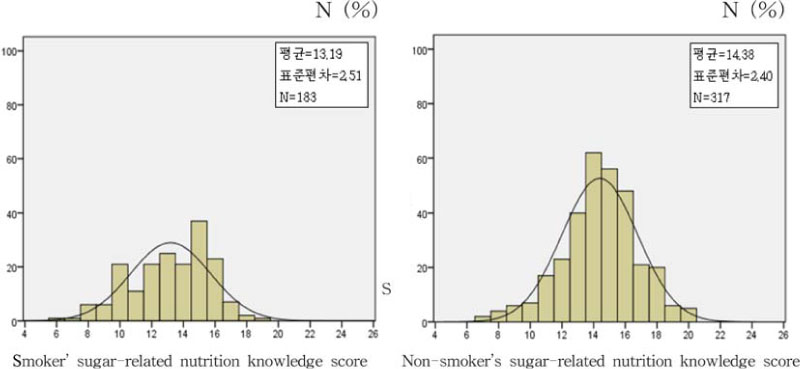
Fig. 1
General characteristics of the subjects
Eating habits and eating behaviors according to smoking status
1) Mean±SD
*: p < 0.05, **: p < 0.01, ***: p < 0.001
Number of snacks per day according to the smoking status
1) Mean±SD
*: p < 0.05
Preferred taste after smoking
Sugar-related nutrition knowledge on the study subjects according to the smoking status
1) Mean±SD
*: p < 0.05
Sugar-related nutrition knowledge according to the smoking status
1) N (%)
*: p < 0.05, **: p < 0.01, ***: p < 0.001
Sugar intake and status according to the smoking status
1) Mean±SD
*: p < 0.05, **: p < 0.01, ***: p < 0.001
Consumption of sugar containing food items according to the smoking status
1) Mean±SD
***: p < 0.001
1) Mean±SD *: p < 0.05, **: p < 0.01, ***: p < 0.001
1) Mean±SD *: p < 0.05
1) Mean±SD *: p < 0.05
1) N (%) *: p < 0.05, **: p < 0.01, ***: p < 0.001
1) Mean±SD *: p < 0.05, **: p < 0.01, ***: p < 0.001
1) Mean±SD ***: p < 0.001

 KSCN
KSCN

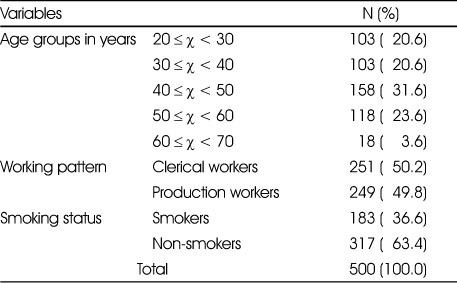
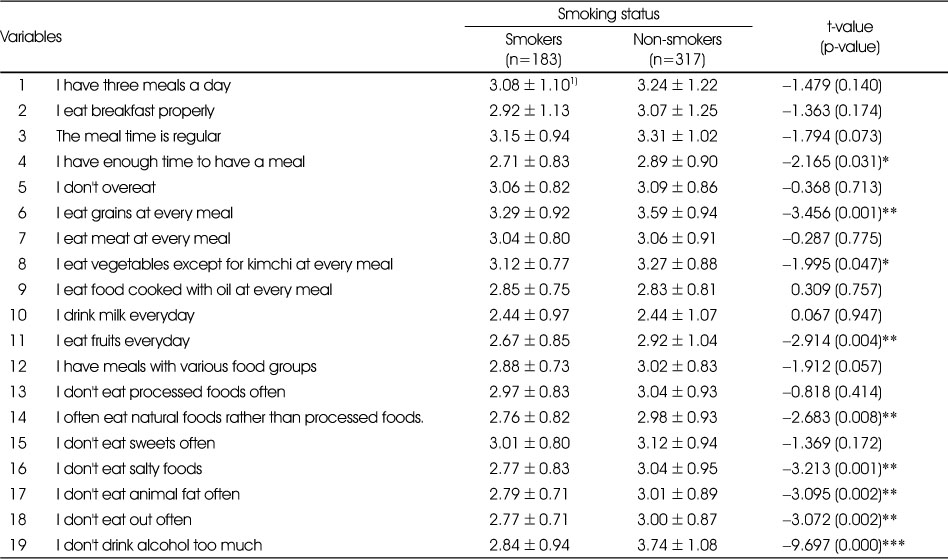

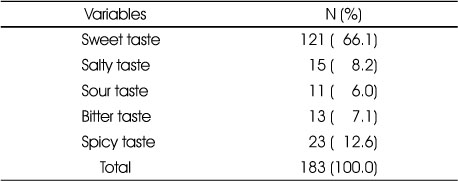

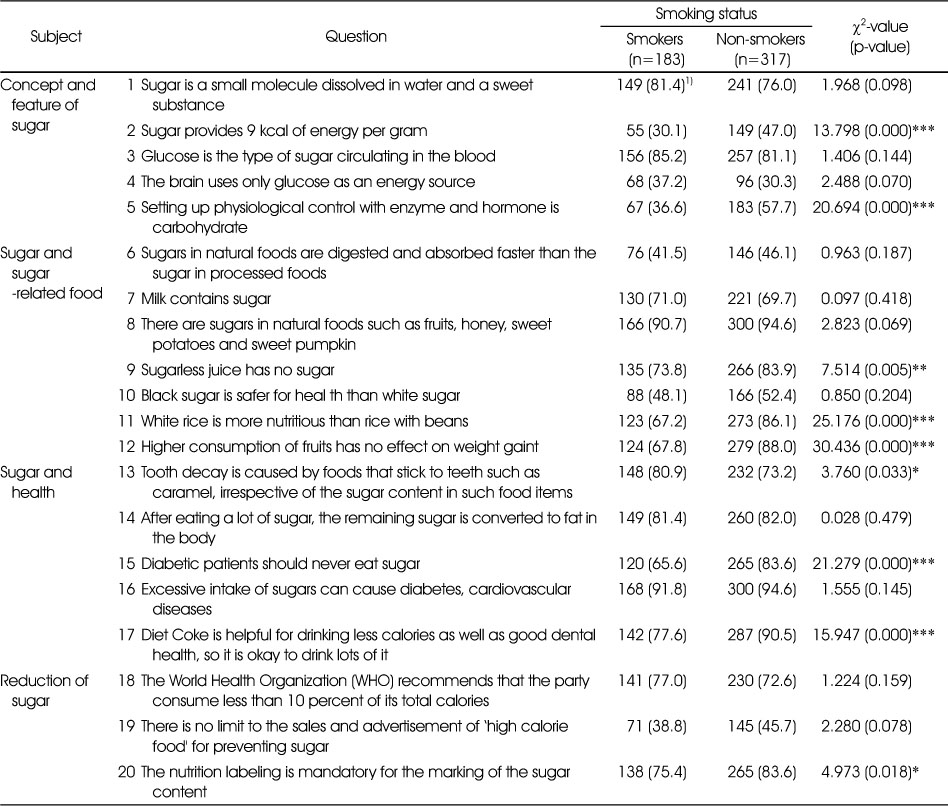

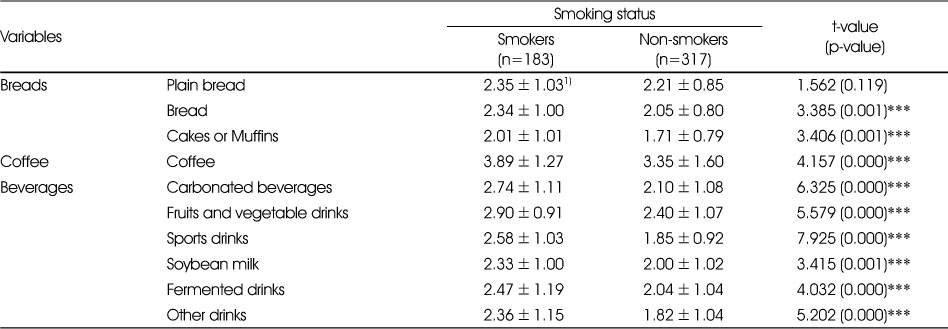
 PubReader
PubReader Cite
Cite


